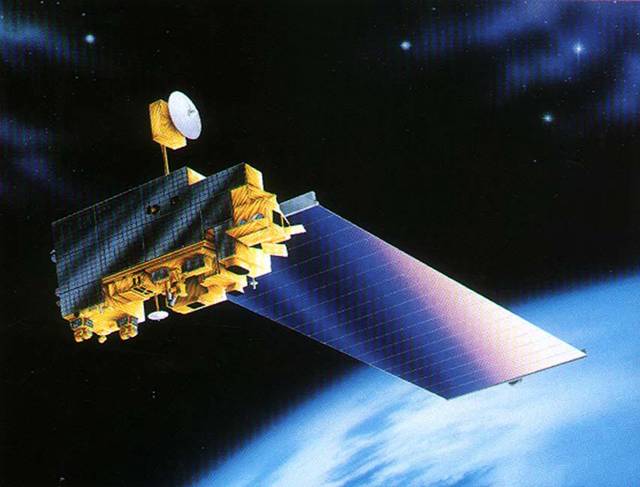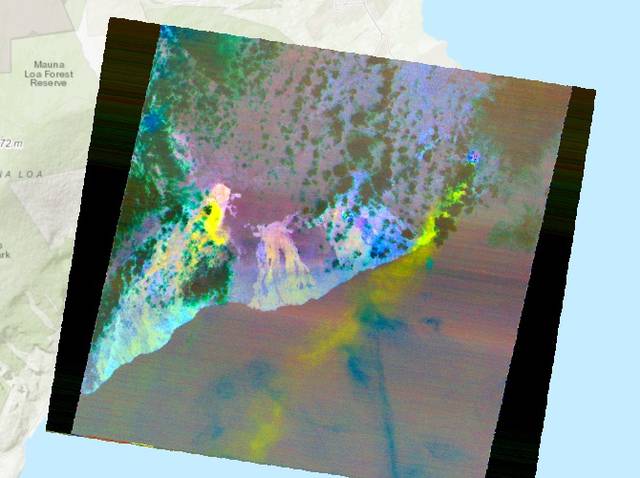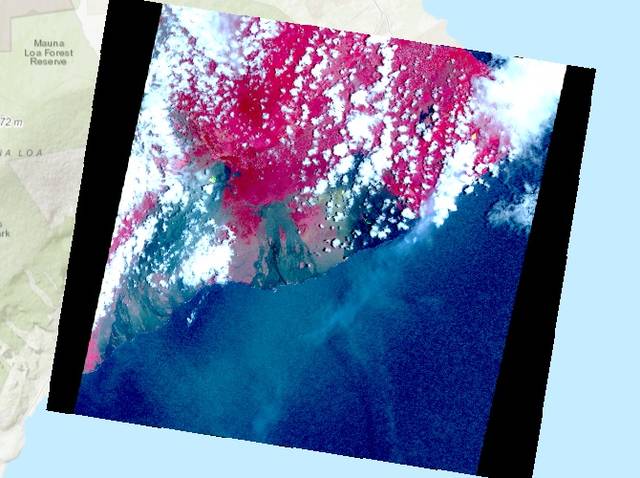As the lower Puna eruption changes the landscape day by day, a tool used to analyze ice is helping scientists learn more about lava.
The Glacier and Ice Surface Topography Interferometer, or GLISTIN, is an instrument pod mounted on a research plane that can measure changes in topography over large areas. As the name suggests, the instrument was designed for use on glaciers and ice sheets, but it is now being used to track the shifting topography of the lava flows.
Paul Lundgren, principal scientist at NASA’s Jet Propulsion Laboratory’s Earth Surface and Interior division, told the Tribune-Herald repeated scans of a landscape using GLISTIN allows scientists to determine the changes to topography over time. When used over the Kilauea flow, GLISTIN not only can map the flow, but determine its thickness.
“If we calculate the thickness, we can determine its volume, and if we know that, we can find out things like the effusion rate,” Lundgren said.
Ultimately, Lundgren said, GLISTIN can help scientists determine the “magma budget” of Kilauea: By determining the thickness of the lava, scientists can estimate how much magma has left the Kilauea magma chamber and how much remains.
“This is the first time it’s been applied to volcanoes, so it’s still experimental,” Lundgren said, adding that GLISTIN is intended primarily as a research tool and is not meant for rapid responses.
Therefore, U.S. Geological Survey has more efficient means of mapping the shape of the lava flow.
As an experimental tool, GLISTIN is still somewhat imperfect, Lundgren said. GLISTIN is designed to work with ice sheets up to 100 meters thick, while the lava flows east of Pu‘u ‘O‘o are 10 meters thick or less, which is close to the lower limit of what GLISTIN can detect.
Furthermore, the data from the different terrain can be difficult to parse. The radar and lidar systems used by GLISTIN are sensitive to the tops of trees, Lundgren said, and can incorrectly interpret treetops as the actual ground level. This can lead to data sets falsely indicating that ground level has decreased when, in reality, lava simply destroyed the trees in its way.
Despite these hiccups, Lundgren said GLISTIN hopefully will help researchers learn more about how Kilauea changes with each eruption.
GLISTIN is not NASA’s only tool employed to analyze the eruption. The Advanced Spaceborne Thermal Emission and Reflection Radiometer, or ASTER, mounted on NASA’s Terra satellite, is being used to analyze sulfur dioxide emissions from Kilauea.
ASTER’s thermal infrared and visible and near-infrared sensor systems allow the sensor to analyze the Earth and its atmosphere through parts of the electromagnetic spectrum far outside of visible wavelengths. This allows it to image, among other things, emissions such as sulfur dioxide.
Vincent Realmuto of the Jet Propulsion Laboratory’s Earth Surface division said Kilauea is a site of increased interest for ASTER since the eruption began.
The sensor is able to image the volcano approximately twice every 16 days and determine the concentration of sulfur dioxide emitted from the eruption sites.
In addition to sulfur dioxide, ASTER can map differences in the flow’s surface properties, mapping the area’s temperature and elevation as the flow progresses, Realmuto said.
Other NASA tools are being employed to analyze the flow. The Visible Infrared Imaging Radiometer Suite detects thermal anomalies, while the Operational Land Imager can generate a detailed image of the flow across multiple spectral bands.
“We’re trying to help as much as we can,” Lundgren said.
Email Michael Brestovansky at mbrestovansky@hawaiitribune-herald.com.











